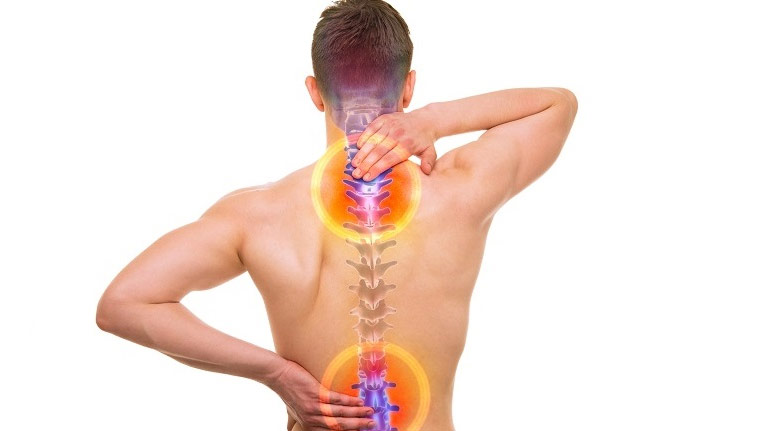Spinal disorders encompass various conditions that affect the spine and surrounding tissues. The spine serves as the central support structure of the body, consisting of vertebrae, discs, ligaments surrounding the spinal cord, muscles, and nerves. These disorders can impact individuals of different age groups and present them with specific symptoms. The common spinal disorders are outlined below:
Back Pain
Back pain refers to discomfort in the lower region of the spine. It can have multiple causes, including muscle spasms, disc herniation, degenerative disc disease, spinal stenosis, spondylosis, spinal curvature (scoliosis), and traumatic injuries. Factors such as poor posture, excessive strain, obesity, smoking, aging, genetic factors, and stress can contribute to back pain. Typical symptoms include tenderness in the affected area, muscle tension, limited mobility, and sometimes radiating pain, numbness, and tingling in the lower extremities.
Neck Pain
Neck pain indicates discomfort in the cervical spine region. The primary causes of neck pain include muscle strains, disc diseases (disc herniation, degenerative disc disease), cervical spondylosis, neck injuries (whiplash), and cervical stenosis. Neck pain is often accompanied by symptoms such as neck pain, stiffness, headaches, shoulder pain, arm pain, and numbness or weakness in the hand and fingers.
Disc Herniation
Disc herniation occurs when the discs between the vertebrae are damaged. Spinal discs consist of a gel-like inner portion called the nucleus pulposus and a tough outer layer called the annulus fibrosus. In disc herniation, the outer layer becomes damaged, and the gel-like substance protrudes outward. This can compress the nerve roots or the spinal cord, resulting in symptoms such as pain, numbness, weakness, and muscle impairment. Disc herniation commonly occurs in the lumbar and cervical regions and can cause sudden pain, pain aggravated by specific movements, or radiating pain in the legs or arms.
Scoliosis
Scoliosis refers to the sideways curvature of the spine. It typically develops during adolescence and is more prevalent among females. The exact cause of scoliosis is often unknown, but it can be associated with factors such as muscle problems, congenital anomalies, spinal injuries, or neuromuscular conditions. Scoliosis manifests as a C- or S-shaped curvature of the spine, which can progress over time. Symptoms may include uneven shoulder height, prominent rib protrusions, spinal curvature, and sometimes back or lower back pain.
Spinal Stenosis
Spinal stenosis occurs when the spinal canal narrows, resulting in compression of the spinal cord and nerve roots. It is commonly associated with the aging process and typically affects the neck or lower back regions. Spinal stenosis can be caused by factors such as bone compression, disc swelling, or the enlargement of spinal joints. Symptoms include pain and numbness in the back and legs, tingling sensations, muscle weakness, balance problems, and increased pain after prolonged walking or standing.
Spinal disorders are individualistic, and each case may vary from person to person. Various factors can contribute to the development of spinal disorders. Treatment options depend on the type and severity of the spinal condition as well as individual circumstances. Maintaining good posture, engaging in regular exercise, practicing proper lifting techniques, and using appropriate mattress support are essential for spinal health. It is advisable to consult a healthcare professional for diagnosis and treatment. An expert can evaluate your symptoms, conduct a physical examination, and, if necessary, utilize imaging tests or other diagnostic methods to accurately diagnose the condition and recommend su

Discover the journey of Osimplant...
Start of production
Our production facilities launched its operations after our R&D activities.
First renowned product osi
Expansion
With the addition of our posterior cervical products, our product range and sales network has expanded.
First European Exhibition
We exhibited at Medica – World Forum For Medicine to engage with European markets.
First specialized industrial meeting
We started exhibiting at EuroSpine where all brightest minds in spine get together.
Innovation
We have launched our biggest innovation project with TUBITAK (Scientific and Technological Research Council of Turkey).
First renowned pediatric system uve
We have engineered our Pediatric Systems JUVE which has been a great success in local and international markets.
Trabecular implant cages terracotta
The trabecular implant cage project is thorough and ready to launch to the markets.
Anvisa certification
We are proud to be the first Turkish manufacturer with Anvisa Certification